What if you could write full, lush and detailed string arrangements that bring your music to life, using your favourite sample libraries?
Discover my step-by-step system for expressive string writing, developing interest within our lines, and pulling the best from our samples.
"As someone that has explored the violin in secondary school, I was always curious on how the string ensemble works together to create expressive music. This course really spoke to me, and as an aspiring composer I wanted to dive into the lessons!
The string section is the backbone of the orchestra.
When we usually think about the symphony orchestra, the strings typically come to mind first, and for good reason. The strings have a timeless sound and a classic character, making them extremely versatile and applicable to many scoring situations.
As orchestral composers and arrangers, the ability to write for strings is absolutely fundamental. Whether you're writing string parts for your own music or orchestrating for a client, having the ability to create full and rich string passages is crucial in today's landscape.
So where do we start?
Many composers go through trial and error, and experiment to see what works, but oftentimes become frustrated and overwhelmed because the strings simply don't sound like how they imagined.
Others hop on YouTube or forums to read tips and tricks on arranging, but there's an endless amount of information out there, not to mention conflicting messages everywhere you turn!
In addition, sample library developers try their best to woo you with their flagship string libraries, promising in-depth sampling like never before, the smoothest legato available, or world class players creating an unbeatable sound.
The cold hard truth...
Now, while equipping yourself with good libraries is definitely recommended, we know that the library doesn't make the composer. It's the knowledge and skills we possess that truly make the difference.
There are hardly any resources out there that teach you not only how to think about the string section, but also the techniques behind arranging, counterpoint, voice leading, and practical application. Many gloss over how certain orchestration techniques work, but rarely apply these concepts to the virtual world, with sample libraries and MIDI controllers.
With technology becoming more impressive by the day, understanding how to get the best out of our sample libraries and create a convincing result is ever more important if you want your music to be taken seriously.
What composers lack is a system to take you from sketch to completed orchestration, and that's why I put this course together.
Introducing: Expressive String Arranging
A comprehensive online course designed to equip you with the framework to write, orchestrate and mockup beautiful, expressive, and rich string passages using your sample libraries.
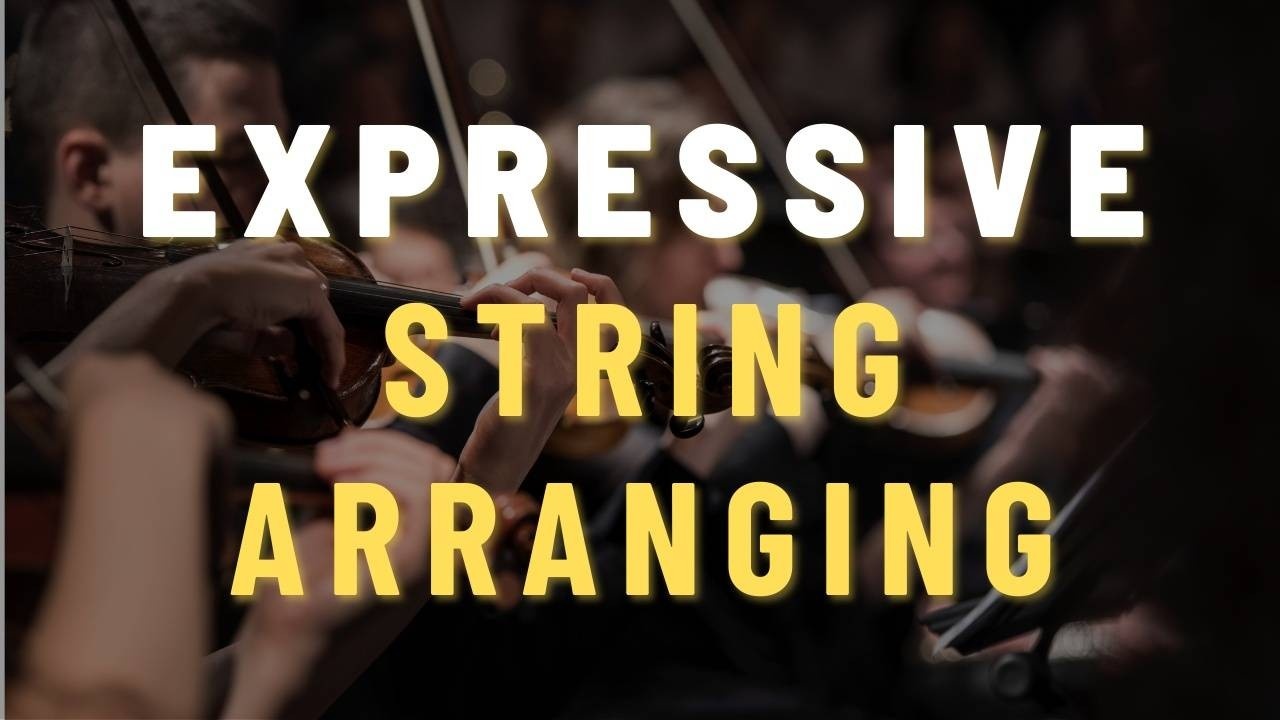
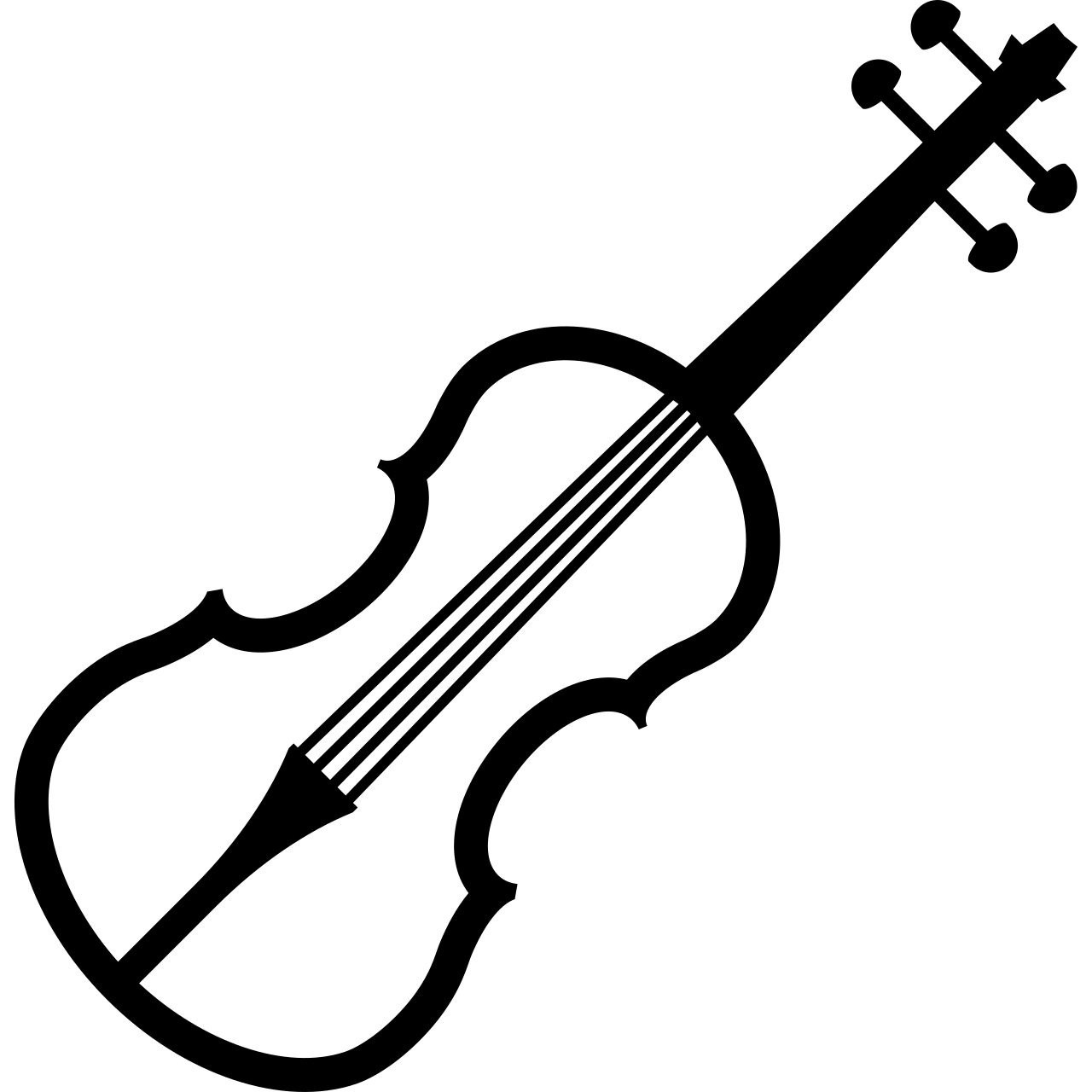
Write idiomatically for the string section
Learn the basics behind the string family and how to arrange them properly.

Create beautiful countermelodies and independence
Achieve interest in your string lines by using counterpoint and smooth voice leading.

Get the best out of your sample libraries
Learn how to take advantage of your library's scripting to create realistic string lines.
Expressive String Arranging is comprised of 3 core modules:
Module 1 - The Fundamentals
The essentials of the string family, including ranges, typical functions, and idiomatic considerations
Typical section sizes for a variety of performance situations
Commonly used articulations and playing styles for expressive playing, with audio examples
The basics of divisi, and when you might need it
Module 2 - Expressive String Arranging Techniques
The 3 arranging approaches you need to know before writing a single note
The #1 secret to full and rich chords, every time
How to orchestrate gorgeous string passages that flow like butter
Extensions and additional colour notes for increased texture and vibrancy
Module 3 - Creating Realistic String Mockups
The foundation behind every convincing orchestral mockup, and my personal performance approach
Sample library recommendations for smooth string performances
The 3 core elements of musicality, and how to apply them
Start to finish masterclasses on composing and arranging string passages
"If you’re looking for a straightforward, easy to understand class on string arranging, this is for you.
Chris demonstrates how each string section functions individually and how they contribute to the overall full string orchestra. He gives you multiple hands-on examples on how to voice strings in a way that go way beyond typical block voicings. Not only will these techniques work with live orchestra, but Chris also dedicates an entire module on how to create realistic string mockups within your DAW.
As with Chris’s other courses, this class will help take your writing to the next level."
- Wayne B. (composer)
By the end of this course, you will:
- Understand how to create gorgeous string arrangements that can stand on their own, without the need for other instruments to support them
- Elaborate on your themes and introduce variety to your parts, using counterpoint and proper voice leading
- Think from the perspective of a string player, resulting in natural and idiomatic lines
- Discover the 10 most common mistakes arrangers make, and how to avoid them
- Use your sample libraries effectively for beautiful and natural string performances
Writing and arranging for strings is an art form in itself. Just because you can play the piano or own $10,000 worth of sample libraries doesn't automatically mean you understand how to use them effectively and orchestrate properly.
The framework is the most important thing. There is no 'best' way to arrange for the orchestra, but having a clear path to follow is critical if you want to improve quickly and stop worrying about whether your string passages sound natural and realistic.
The method I share with you in this course is the exact approach I use in my arrangements and teach my private students. Once you learn, apply, and become comfortable with the process, it will seriously make orchestration so much more freeing and fun for you.
That's been my goal for you with all my products since day 1, and this course is absolutely no exception.
You can do this.
So how much does Expressive String Arranging cost?
Honestly, there's so much free information out there that you could cobble it all together and pick and choose what works for you. Trust me, I've done that! The only problem is, this takes TIME. And if you're like me, you want to get results QUICKLY.
This is why courses are wonderful, and why I'm sharing this with you. Similar courses out there charge hundreds to thousands of dollars to learn the same stuff, yet take hours of your time to really hone in on the core elements that can really transform your work once and for all.
What would it be worth to you to learn a system that you could implement within minutes to make your string passages sound passionate, full, and realistic?
My private lessons begin at $200/hour, but I want to make this such a no-brainer for you, so you'll have instant lifetime access to the entire program instantly for a simple one-time payment of $247.
You can grab Expressive String Arranging today for a simple one-time payment of $247!
To sweeten the deal, I'm including some sweet exclusive bonuses when you join today.
Bonus 1: Arranging for Pop and Exciting Strings (video tutorial)
Rather than just focusing on legato and sustained strings, this video will share my approach to arranging for active staccato strings.
It's a slightly different approach to the former, but great to know in those cases where you'd need to write for pop, rock, disco, or other animated styles.
Bonus 2: Creating Orchestral Transitions (video tutorial)
This is one of the questions I receive the most. How do you actually create smooth orchestral transitions that flow naturally from one section to the next?
This video will pull back the curtain on my process, and you'll see what instruments I use, and how I use them for effective transitions.
Bonus 3: Adding in the Rest of the Orchestra (video tutorial)
After our strings have been laid down, how do you actually go about adding in the other orchestral sections (winds, brass, and percussion)?
While each style has a different approach, you'll discover my personal framework for creating woodwind lines that breathe, brass parts that create warmth and depth, and percussion that emphasizes the important moments and creates ear candy for the listener.
Bonus 4: An interview with violinist Carmen Lasceski-Custers
How does a string player think about music? What are some best practices for smooth string passages? What are some no-no dealbreakers when it comes to string orchestration?
Learn these insights and many more in this wonderful interview I had with my friend Carmen!
Some common questions...
Will I have lifetime access?
What results can I expect?
How in-depth does the material go?
What if I'm unhappy with the course?
Are there any prerequisites required?
Do I need to be able to read sheet music?
So here's what you're getting when you sign up for Expressive String Arranging Today:
- The entire Expressive String Arranging course with 3 dedicated modules ($297 value)
- BONUS: How to create orchestral transitions ($25 value)
- BONUS: How to write for energetic strings ($25 value)
- BONUS: Adding the rest of the orchestra with the strings ($25 value)
- BONUS: Exclusive interview with violinist Carmen Lasceski-Custers ($50 value)
You'll have access to all this training ($400+ value) for a simple one-time payment of $247!
"I'm very new to orchestration, mockups, and arranging. I bought a course a few years ago, but it was so intimidating and convoluted that I became overwhelmed and gave up after a bit.
I came across your YouTube channel and instantly became excited again! I purchased this course and am so glad I did.
Christopher has a way of explaining concepts in layman's terms, but not too watered down or elementary. The course has a perfect mixture of lecture and audio/video examples, and even had MIDI files for me to study and experiment with.
I really appreciate this course, and look forward to purchasing again soon!"
- Damian (composer)
Don't want the bonuses?
No problem! You'll still have access to the core material, but the bonus videos and exclusive interview won't be included.
You can purchase the basic version of the course for only $197.
“When I started I knew something about orchestration. I had gaps in my knowledge because of being self-taught. Being a pianist, I built from the rhythm section up and the orchestra was background support.
This course brought to my consciousness the subtlety of instrumental sounds as they blend with each other within and alongside the respective sections of the orchestra. What sounds played by what instrument or combination of instruments in order to convey what emotion.
This course provides the tools and the mechanics to bring inner-being to a new and different level of development. I highly recommend this to anyone regardless of their current ability on their instrument.
Trust me on this one, the joy is in the journey...so get on board!”
- Ron Granger (composer)

By the way, it's completely risk free!
If you're not satisfied with the course for any reason, simply email me within the first 30 days for a 100% refund!
I want you to feel completely comfortable in your investment, so if you're unhappy with the course, I'd rather you invest it somewhere else where it'll be more beneficial to you.
See how Expressive String Arranging is transforming these composers' string arrangements!


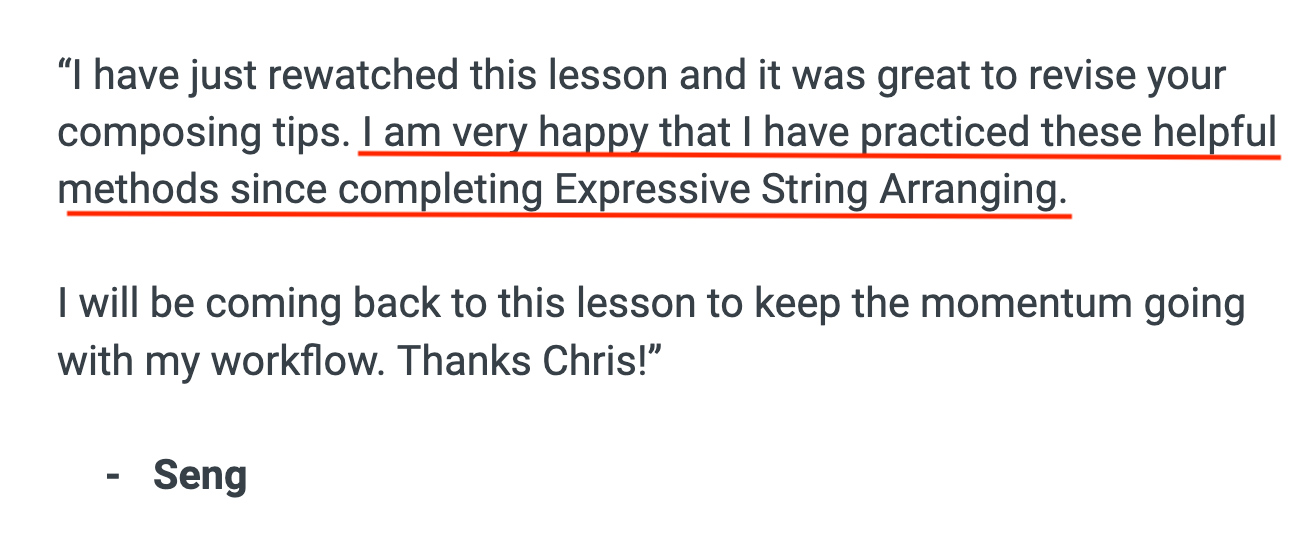

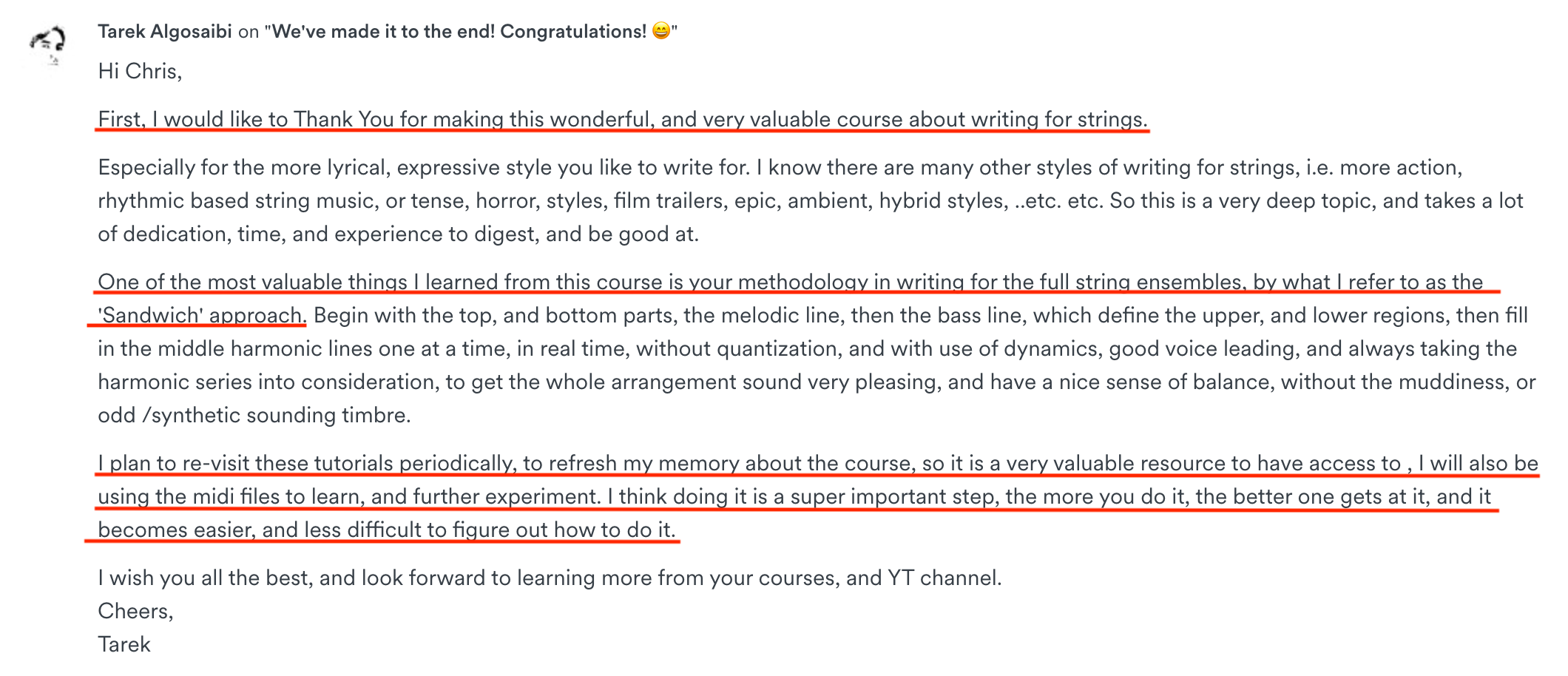
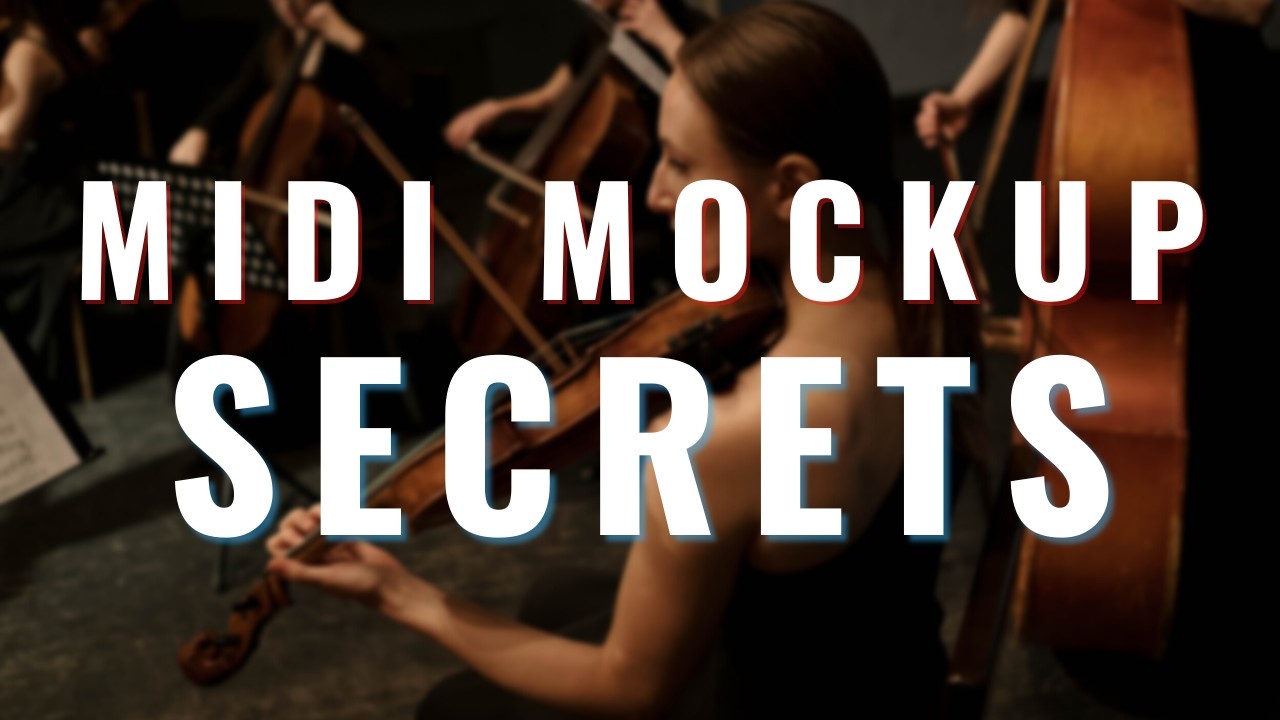
Are you ready to take control of your string arrangements?
There are 2 types of composers.
On the one hand, you can continue to guess your way through your arrangements, being unsure of how to voice your instruments properly, how to create proper dynamics and phrasing in your parts, and feeling frustrated that your mockup simply doesn't sound the way you envisioned.
On the other hand, you can understand exactly what goes into a clean and realistic string mockup, following a step-by-step process to ensure you create an arrangement that breathes, sounds natural, and is full of life.
You just need to understand how, and that's why I'm sharing Expressive String Arranging with you.
Join today and take your string arrangements to the next level, and be proud to share them with the world.
All in all, a great jumpstart into string arranging!"
